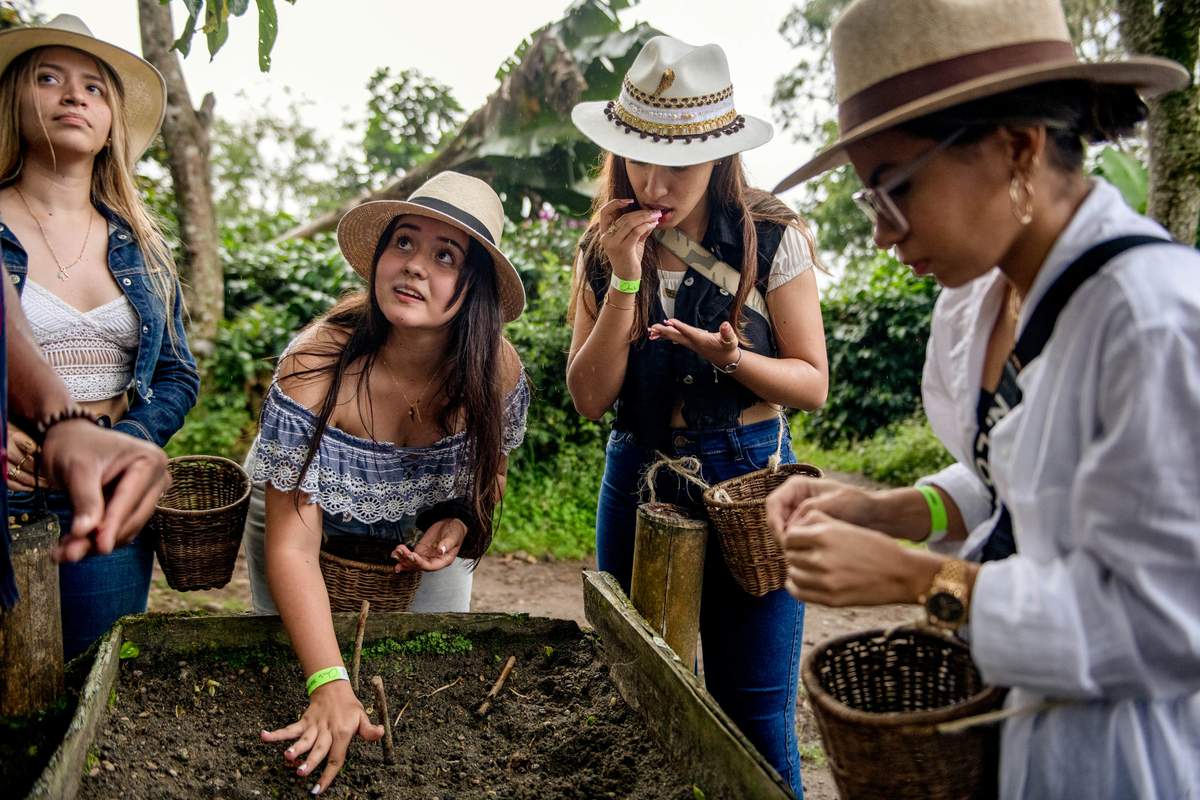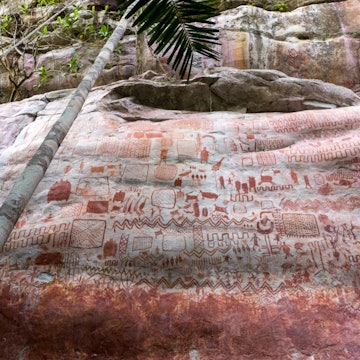

The Wayúu of La Guajira have a long weaving tradition. Anamejia18 / Getty Images
Bright and colorful, Wayúu mochilas (bags) are one of Colombia’s most famous artisan products. Meticulously hand-stitched by the Wayúu indigenous people of La Guajira in northeast Colombia, the mochilas are more than exquisite craftsmanship; Wayúu textile art tells handwoven stories and represents a tradition that has been passed down for generations since pre-colonial times.
Defenders ’til the end
Known as the “people of the sun, sand and wind,” the Wayúu have lived in the semi-arid, Wild West landscape of La Guajira peninsula, where the desert meets the Caribbean Sea at the northernmost point of South America, for centuries. Fiercely territorial and wisely learning how to use firearms and ride horses, they are among few ethnic groups in Latin America to have successfully resisted European colonization. They continue to live on their ancestral lands following their own complex and autonomous social, political and economic rules.
At present, they are Colombia’s largest indigenous group, with estimates of more than 250,000 people divided into some 30 matriarchal clans who live in traditional rancherias – small, isolated communities made up of several houses – between Colombia and Venezuela (the Wayúu are transnational and don’t believe in borders).
Their isolation, together with a proud and tenacious attachment to their land and culture, has enabled them to preserve their unique culture – transmitting ancient rituals and traditions using the Wayuunaiki language, which is still spoken throughout the region.
The meaning of weaving
As the Wayúu saying goes, “To be a woman is to know how to weave.” The tradition of weaving is highly respected within their matriarchal culture and is a symbol of wisdom, creativity, intelligence and status. Every clan can be distinguished by a particular woven pattern.
A Wayúu girl learns the ancient craft from her female relatives during her sacred coming of age ritual that begins with her first menstruation. As the Wayúu are staunch matriarchs, this rite of passage prepares women for their leadership role. During the “confinement,” as it’s called, girls live in isolation for up to several years and are taught the customs and beliefs of the Wayúu, how to take care of a home, how to cook, how to mediate conflicts and how to weave.
The mythological origin of the weaving tradition can be traced back to a wise spider called Walekerü, who, according to legend, taught the first Wayúu women how to weave creative patterns into different accessories. Their most representative creations are hand-stitched blankets and chinchorros (traditional Wayúu hammocks) and a variety of mochilas, each with a particular use. The most common mochila is the Susu, roughly translated as “everyday wear,” a small-sized shoulder bag used to carry personal items. Others include the large Ainacajatu and the very resistant mesh bag, Kattowi, used to transport water-filled múcuras (ceramic pots).

Inspired by nature
During the weaving process, artisans use yarn (acrylic thread has replaced natural fibers) to single- or double-thread multi-patterned textiles that are charged with meaning and symbolism. The patterns are called Kanaasü, which translates to “the art of weaving drawing,” and are a collection of intricate geometric designs – each with a specific name and meaning – inspired by Wayúu cosmology, legends and the natural landscapes that surround them.
Every handcrafted item is, therefore, unique to the individual weaver who uses Kanaasü to represent elements of her environment, daily life, society and view of the universe – her work tells a story, describes her dreams and is, essentially, a reflection of her soul. Depending on the crochet design, a single mochila can require up to 25 days – a hammock can take over a month – of intensive work for one Wayúu woman to complete; the more elaborate the designs and figures are, the more valuable the piece is.

From the deserts of Colombia to the world
Selling handwoven creations to people outside their tribe has become a significant source of economic income for Wayúu women, the main providers of their families. The hostile desert conditions, worsened by terrible droughts, armed conflict, extreme poverty, human rights violations and corruption, mean the Wayúu cannot live off the land anymore.
As mochilas gain popularity with both tourists and in the fashion industry, appearing on international catwalks and hanging off celebrities’ shoulders, it is crucial that the bags are not detached from the indigenous people who make them and the ancient traditions they represent. Wayúu textile art is a cultural heritage – its origins must be acknowledged and respected and the artisans adequately paid for their work.

Tips for buying Wayúu crafts
The best place to buy authentic, handmade Wayúu products at a good price is right at the source in La Guajira such as Riohacha or Cabo de la Vela, as well as in cities along the Caribbean coast. Avoid haggling too much – remember that every mochila requires a huge amount of physical and emotional energy to create. Alternatively, you can pick up a bag at most handicraft markets around Colombia, including the Usaquén Market in Bogotá or the Artesanías de Colombia, which gives a percentage of the profits back to the indigenous artisans. Buying online is also an option, but be sure the company acknowledges the Wayúu as the skilled creators and isn't just copying Wayúu designs; Lombia + Co and Wayuu Mochila Bags are responsible sellers.
Travelers can also discover Wayúu culture by visiting a traditional ranchería. Some Wayúu clans near tourist towns in La Guajira are allowing outsiders into their villages to learn about their fascinating life out in the wild desert. Visitors can participate in ancestral traditions, sample local food and of course, buy arts and crafts.
Make sure you're ready for anything with travel insurance from our trusted partners.














